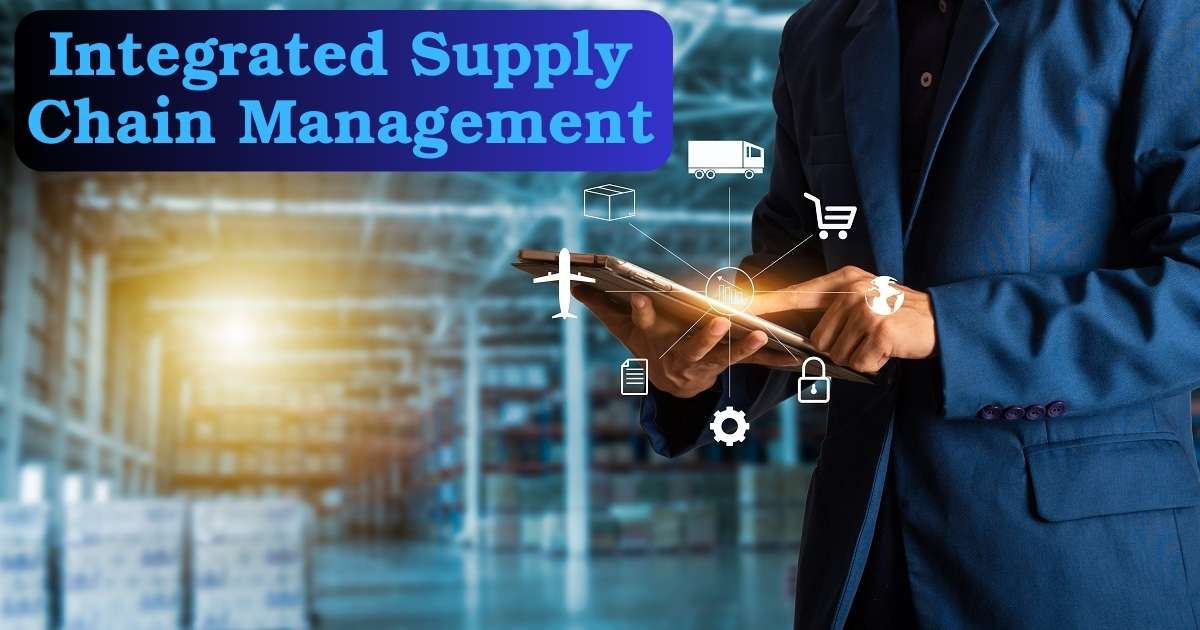In today’s fast-paced business world, conventional supply chain management (SCM) simply doesn’t cut it anymore.
You need a cohesive, coordinated strategy that unites every link in your supply chain – from raw material sourcing to manufacturing to logistics.
That’s where integrated supply chain management (ISCM) comes into play, representing a seismic shift in how companies approach their operations.
At its core, ISCM is about streamlining processes, boosting efficiency, and enhancing resilience across your entire supply network.
It breaks down the silos between different segments to create a synchronized, collaborative system fueled by end-to-end visibility and data-driven insights.
With ISCM, you’re not just reacting to disruptions – you’re proactively mitigating risks and capitalizing on opportunities.
The Evolution Towards Integrated Supply Chains
Traditional SCM treated each step – procurement, production, distribution – as separate entities.
But in our hyper-connected global economy, that fragmented approach is a recipe for chaos. A single hiccup at any stage can trigger a domino effect of delays, costly inefficiencies, and customer dissatisfaction.
Enter ISCM, a paradigm shift that recognizes the interdependence of every supply chain process. By fostering integration and real-time communication, ISCM empowers organizations to:
- Gain unprecedented visibility into every aspect of their operations
- Respond swiftly to changes in demand, resource availability, or market conditions
- Optimize processes through seamless collaboration and coordinated decision-making
As you’ll see, this integration can occur horizontally (between competitors) or vertically (across different supply chain tiers). Both approaches aim to create a unified, resilient supply network aligned towards common goals.
How to Integrate a Supply Chain: Horizontal Vs. Vertical Integration
Horizontal Integration: This strategy involves merging with or acquiring similar companies operating at the same level of the supply chain. For example:
- The Walt Disney Company acquired animation studios like Pixar, Marvel, and Lucasfilm between 2006-2012. These “horizontal” moves expanded Disney’s content offerings and market reach.
- In 2016, Marriott International purchased Starwood Hotels & Resorts, creating the world’s largest hotel company and reducing competition.
- Kraft Foods merged with Heinz in 2015 to form a processed food conglomerate with massive economies of scale.
You’re Sure to Come Across Examples of Horizontal Integration in the News
One of the most high-profile horizontal integrations was Facebook’s $1 billion acquisition of Instagram in 2012.
At the time, Instagram was a rapidly-growing threat – by absorbing the rival, Facebook eliminated a competitor while expanding its social media dominance. The deal proved incredibly lucrative, with Instagram now valued at over $100 billion.
Vertical Integration:
In contrast, vertical integration involves a company acquiring businesses at different stages of the same production path – either:
- Forward integration: Gaining ownership of distribution channels/retailers
- Backward integration: Taking control of suppliers of raw materials/components
- Balanced integration: A blend of both forward and backward moves
For example, major oil firms like ExxonMobil, BP, and Shell are vertically integrated mammoths. They own:
- Upstream exploration/extraction divisions (backward integration)
- Refineries that process crude oil (manufacturing)
- Downstream retail outlets for selling gas (forward integration)
This permits tight oversight of the entire value chain, from locating oil reserves to fuel pricing.
| Oil Company | Upstream | Midstream | Downstream |
| ExxonMobil | Yes | Yes | Yes |
| BP | Yes | Yes | Yes |
| Shell | Yes | Yes | Yes |
Amazon leverages vertical integration for its e-commerce operations through:
- In-house logistics/delivery (forward integration)
- Private labels like Kindle (backward integration into manufacturing)
And Starbucks has embraced a balanced approach by:
- Owning its roasting facilities/equipment (backward)
- Partnering directly with coffee growers (backward)
- Operating its own cafes/stores (forward integration)
As these examples illustrate, both horizontal and vertical supply chain integration strategies can reduce costs, boost quality control, and amplify a company’s market dominance.
How Supply Chain Integration Represents a Sea-Change in SCM and Logistics
So what exactly separates integrated supply chain management from conventional approaches? ISCM revolves around four key tenets:
- Integrated Planning: Rather than working in isolation, companies collaborate to create unified strategic roadmaps that account for interdependencies and shared objectives.
- Integrated Execution: Every aspect – from procurement to production to distribution – operates as a synchronized, coordinated effort guided by real-time data exchange.
- Integrated Visibility: There’s complete transparency across the supply network, with relevant information freely flowing between partners to facilitate rapid decision-making.
- Integrated Management: Leveraging big data, analytics, and cutting-edge tech like AI/ML, companies can holistically track performance, identify inefficiencies, and course-correct as needed.
This profound shift from a fragmented, sequential model to an interconnected ecosystem is facilitated by new technologies:
- Cloud Computing: Enabling seamless data sharing and centralized oversight
- Internet of Things: Sensor networks provide real-time monitoring of assets, shipments, etc.
- Blockchain: Ensuring tamper-proof record-keeping and contract verification
- Predictive Analytics: Forecasting demand/risk through machine learning algorithms
Collectively, these innovations allow ISCM to fulfill its promise of end-to-end integration and visibility.
Supply chain managers transcend their formerly siloed roles, operating as conductors coordinating the entire symphony of people, activities, and resources across the value chain.
The Risks and Rewards of Integrating a Supply Chain
Like any transformative business strategy, integrated supply chain management comes with its own set of potential rewards and risks to weigh carefully.
Advantages of ISCM:
- Increased Efficiency: By eliminating redundancies, streamlining handoffs, and synchronizing workflows, ISCM drives considerable cost savings and productivity gains.
- Higher Customer Satisfaction: When all supply chain processes are optimized, products/services can be delivered faster and with higher quality.
- Accelerated Product Cycles: With fewer intermediaries and smoother collaboration, ideas can rapidly transition from conception to market.
- Supply Chain Resilience: Full supply network visibility enables rapid disruption response and risk mitigation.
- Competitive Advantage: Companies can outmaneuver rivals through operational excellence, market insight, and economies of scale.
Potential Challenges:
- High Upfront Costs: Mergers/acquisitions, new systems/tech adoption, employee training – the price of ISCM can be steep initially.
- Change Management: Overcoming institutional inertia and aligning disparate corporate cultures is an obstacle.
- System/Process Integration: Merging data systems, workflows, standards etc. across partners is an immense technical challenge.
- Loss of Autonomy: Companies sacrifice some independence by binding operations so tightly to external partners.
- Overreliance on Partners: If a key integrated supplier underperforms, it can crater the entire supply chain.
Nevertheless, many organizations find the long-term benefits of ISCM more than justify the transitional pains. With proper planning and robust partnerships, the integration payoffs in terms of cost, quality, speed, and resilience can be game-changing.
Integrated Supply Chains are More than Just a Sum of Their Parts

At its highest level, truly integrated supply chain management transcends transactional buyer-supplier relationships. It’s a multi-dimensional embrace of shared ownership over processes and outcomes.
Consider the relationship between Starbucks and its coffee growers. It’s not a typical vendor contract – it’s a strategic partnership with knowledge sharing, joint capacity planning, and aligned incentives for quality/sustainability.
This deep collaboration and transparency is replicated across Starbucks’ entire supply chain.
Integrated supply chains continuously share real-time data (sales forecasts, inventory levels, potential disruptions) to enable collaborative planning and rapid course correction.
There’s no “invisibility” between handoffs – every partner has full line of sight into the entire supply network’s performance.
This degree of connection and interdependence ultimately produces supply chain “networks” that behave more like unified companies than loose confederations of partners.
Shared software systems, processes, and metrics create convergence around unified goals:
- Global Supply Chain Optimization
- Improved Asset Utilization
- Faster Response to Market Dynamics
- Maximized End-to-End Profitability
The future of ISCM envisions even tighter symbiosis between partners. Technologies like the Internet of Things, blockchain, and AI/ML will drive further integration by enabling advanced capabilities like:
- Autonomous Logistics: Self-orchestrating shipments and fleet management through machine learning
- Predictive Maintenance: AI-driven asset monitoring to preempt equipment failures
- Smart Contracts: Blockchain-enforced multi-party supply chain agreements
- Generative Design: AI-optimized product designs for efficient manufacturing
As former CEO of Unilever Paul Polman stated:
“Integrating your suppliers across the entire value chain… is one of the most crucial sources of innovation and competitive advantage.”
The leading brands dominating their respective markets have already embraced the ISCM mindset. Amazon’s tentacles extend from cloud services to entertainment to grocery.
Apple management its hardware, software, and services as a unified ecosystem. An integrated approach is key to thriving amid today’s global, hypercompetitive landscape.
Conclusion: Is Your Supply Chain Ready to Integrate?
The shift towards integrated supply chain management is more than just a passing fad – it’s an existential business imperative.
In a world of heightened volatility and disruption, the organizations that will succeed are those that can rapidly adapt by harnessing end-to-end integration and visibility.
As we’ve explored, ISCM breaks down institutional silos and unites companies through shared strategies, processes, and digital infrastructures.
Horizontal integration increases market power through mergers and acquisitions, while vertical integration cements control over a company’s entire value chain.
But thriving in this new reality requires much more than boardroom dealings. It demands a fundamental shift in mindset – one that views supply chain performance not as a series of discrete handoffs, but as a holistically connected and collaborative ecosystem. Leaders must champion:
- Cross-Functional Alignment: Breaking down organizational barriers and P&L silos
- Data-Driven Decision Making: Democratizing access to insights and intelligence
- End-to-End Process Optimization: Continuously improving global supply chain flows
- Risk Management & Resilience: Proactively identifying and mitigating disruptions
This is admittedly an arduous journey requiring significant investments in technology, talent, and change management.
But the potential rewards – heightened efficiency, agility, customer satisfaction, and profitability – are simply too great to ignore.
The future belongs to those organizations bold enough to truly integrate their supply chains into unified, resilient operating models.
An optimized, tech-driven, collaborative supply network is no longer a luxury – it’s a must-have competitive weapon. The time to start building your integrated supply chain advantage is now.

With a wealth of expertise spanning 6 years, I am a seasoned author in the realm of courier services information. My insights illuminate the intricacies of logistics and delivery solutions.






![Julia Boin JAV Bio, Net Worth, Career & Relation [2024 Complete Guide]](https://courierplate.com/wp-content/uploads/2024/11/Julia-Boin-JAV-Bio-Net-Worth-Career-Relation-2024-Complete-Guide-300x157.jpg)




